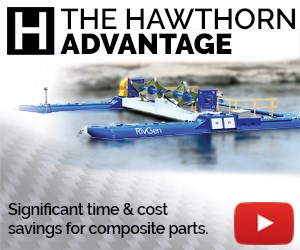The Composite Car That Should Have Been
A plastics consultant since 1973, Bill D. Snow established E.M.C. Co. in Ft. Worth, Texas in 1960 and, in 1962, designed and built a fully automated thermoforming machine for his own use that, by 1965, was being sold to other plastics manufacturers through E.M.C.'s Machinery Division. In 1967, E.M.C. Co., renamed
Hardly an issue of this magazine goes to press these days without some automaker announcing that a new or updated model will have some or all of its exterior components made from composites. It always reminds me of a time when such announcements were rare.
In 1974, Malcolm Bricklin invited me to the preview party for his forthcoming sportscar, the Bricklin. The flamboyant auto entrepreneur had reserved the Four Seasons Restaurant -- an entire floor of the Seagrams building in New York City. When I walked in, the place was already wall-to-wall with well-dressed investors, politicians, celebrities and masses of media people viewing, with obvious fascination, large artist's conceptions of the car's sleek body and gull-wing doors. In one exhibit, a beautiful model took swings at an actual Bricklin fender using an over-sized hammer, in a very effective demonstration of the toughness of the material that was to be used to make the body parts. I was drawn to this particular display because that very fender had been molded in our Ft. Worth, Texas shop only a few days earlier.
It had never dawned on me that so many people could be so excited about a car that had not yet been built. Equally surprising was that the materials and processes my company, the Snow Corp., worked with every day had been proclaimed "advanced technology." But the Bricklin was to be the first full-size car in the world to have a composite body that required no paint. The exterior surface would be a thermoformed, colored acrylic surface backed by a comolded substrate of glass-reinforced polyester composite. My firm had contracted to build the molds and the machinery the Bricklin Motor Corp. would use to manufacture the car's 22 exterior body parts.
Our group always thought it was a shame that the Bricklin program did not survive, but I get sweaty hands when I recall with hindsight what a thin financial thread our company held on to through our part in the car's development.
Our involvement began when George Rahman, vice president of General Vehicle Inc. (Detroit, Mich.), Bricklin's parent company, called to tell me he had a problem. He wanted to produce a new car with a reinforced acrylic body, but after spending a large amount of money on epoxy thermoforming molds, they had been unable to consistently form satisfactory acrylic shapes. They were starting over, he told me frankly, and this time he was following the advice of an expert who had directed him to me.
Rahman's description of what they wanted sounded a lot like the Press Reinforcing process we had spent four years developing for bath tub fabricators. Motivated by his candor and my own curiosity, I accepted his invitation to Detroit.
We toured Bricklin's shop and then visited their toolmaker, Visioneering Inc. Visioneering had the first computer-operated milling machine I had ever seen. It could mill in three dimensions from a flat blueprint -- a new one on me. With the mill, Visioneering could make mahogany patterns accurately and much faster than our own pattern shop could by hand. It was easy to foresee a very satisfactory collaboration: They could make the patterns with built-in shrink, and we could use them to cast aluminum molds to exact size.
In a conference room with about 20 cigar-smoking Bricklin engineers and a full blueprint of the car, I was given a pointer and asked to call attention to areas I thought might need some design modification to ensure that plastic body parts could be produced. It soon dawned on me that everyone in that room was well experienced at building cars out of steel and, therefore, I was getting nowhere. As the smoke grew dense and the grumbling grew louder, I finally yelled for everybody to shut up (I'd done nothing like that, before or since!) and told them that I had been asked to give my opinion about how to make a strong acrylic body for this car. If they did not want to hear it, I was wasting my time. I'm sure they thought I was some kind of nut, but they quieted down and we completed the review without further incident.
Later that day, I told Rahman I was satisfied that we could do the job, but I needed several days back in Ft. Worth to develop a plan. The quotation we presented included 22 cast aluminum thermoforming molds for the acrylic skins; 22 matched cast aluminum water-cooled molds, for comolding the formed acrylic with a glass-reinforced composite in a closed molding process; plus the large reinforcing presses and thermoforming machinery -- everything except the master patterns, which would be cut by Visioneering. Fortunately, the proposal also outlined a progressive payment schedule: If there was a delay in payment on an interim invoice, work would cease until the account was brought current. (That was our policy on extended projects. I believed the buyer should be the one most heavily invested so that 100 percent of our energies could be given to getting a job done instead of worrying about money.)
After we sent the proposal, Malcolm Bricklin himself appeared at our plant for an afternoon to "see what we were made of." Afterward, Rahman called to explain that his associates needed some proof that we could produce what we had proposed. I suggested that Visioneering supply us with the master pattern for the right front fender, complete with a checking fixture. We would make the cast aluminum mold, test-form the acrylic fender, reinforce it with chopped fiberglass (saving time), check it in the fixture and ship the sample fender ... in one week. I figured that if this kind of performance didn't shock Bricklin's metalheads into belief, nothing would. It also would demonstrate to my team that what we typically required four to six weeks to produce could actually be done at such a break-neck speed, under the right circumstances. It would wipe out any doubts they had about taking on such a sizeable project. When we delivered as promised, I shortly received a letter that said simply, "You have made history!" It was signed, "Malcolm."
A purchase order soon arrived for everything but the mold sets for the closed molding process. I was told they would come later. Since it would be several weeks before we would need to start the matched molds, I thought little of it, but in hindsight, it was the first sign that the fledgling carmaker was struggling.
We approached the job like we were preparing for the invasion of Normandy and actually had few problems, other than having to halt work two or three times until interim invoices were paid.
We soon learned that Bricklin had elected not to use our cast aluminum tooling for the closed molding process. They had decided on epoxy -- a strange decision in light of the fact that epoxy thermoforming molds had eaten Bricklin's lunch in the first place and prompted Rahman's call for help. I knew from hard experience that epoxy would not be satisfactory in production. It was clearly an attempt to cut cost and we wanted no part of it, so they awarded that work to another firm.
Along the way, there was further evidence of financial strain: At one point, Albert Bricklin, Malcolm's father, paid a pop visit to our company and insisted that we have everything installed in their facility by an impossibly early date. I told him it would be April of the following year, and even that would hinge on Bricklin's adherence to our payment terms. His face turned as red as a fire truck. He immediately placed a call to Malcolm to repeat what I'd said, then departed and I never saw him again. Shortly after, we received another surprise visit, from an officer of First Pennsylvania Bank worried about the substantial loan it had made to Bricklin for the project.
When we finished the 22 production forming molds, we test-formed the 80-mil sheet acrylic for the body parts, reinforced and trimmed them and sent them to Detroit. Shortly thereafter, one of their men drove a prototype built with our parts to our Ft. Worth facility on his way to Phoenix, Ariz. for crash tests. It was a very satisfying sight. Nobody had any idea how the car would survive a crash test, so automobile people were quite surprised when it outperformed metal-bodied cars. In fact, when the car debuted in late 1974, it was dubbed the Bricklin SV-1 (SV short for Safety Vehicle).
Sometime after the Four Seasons preview, we crated the machinery and loaded it on two flat railcars for the trip to Bricklin's factory in New Brunswick, Canada. We sent technicians to supervise the installation and train Bricklin personnel. Although our group continued to assist Bricklin's production personnel by phone, in the main, the problems they experienced involved (as I had feared) the epoxy closed molds, for which we weren't responsible.
Ultimately, only 2,854 cars were built before the company went bankrupt in 1976. I will always feel sad about that, because the Bricklin was so very close to being a very good car. Since so much has been written about the number of Malcolm's ancestors on the payroll, I've often said that the company must have suffered from internal combustion. A great idea became another blurred vision.
Read Next
CW’s 2024 Top Shops survey offers new approach to benchmarking
Respondents that complete the survey by April 30, 2024, have the chance to be recognized as an honoree.
Read MoreFrom the CW Archives: The tale of the thermoplastic cryotank
In 2006, guest columnist Bob Hartunian related the story of his efforts two decades prior, while at McDonnell Douglas, to develop a thermoplastic composite crytank for hydrogen storage. He learned a lot of lessons.
Read MoreComposites end markets: Energy (2024)
Composites are used widely in oil/gas, wind and other renewable energy applications. Despite market challenges, growth potential and innovation for composites continue.
Read More

























